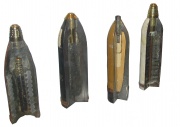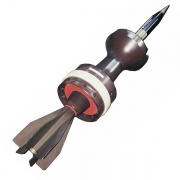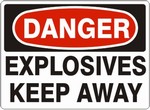Shell (projectile)
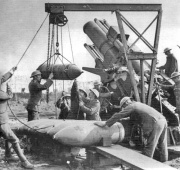
A shell is a payload-carrying projectile, which, as opposed to shot, contains an explosive or other filling, though modern usage includes large solid projectiles previously termed shot (AP, APCR, APCNR, APDS, APFSDS and Proof shot). Solid shot may contain a pyrotechnic compound if a tracer or spotting charge is used.
Shells are usually large rounds fired by artillery, armored fighting vehicles (including tanks), and warships.
Shells usually have the shape of a cylinder topped by an ogive-shaped nose for good aerodynamic performance, possibly with a tapering base; but some specialised types are quite different.
History
Written evidence for the first explosive shells appears in the early Ming Dynasty (1368–1644) Chinese military manual Huolongjing, compiled by Jiao Yu (fl. 14th to early 15th century) and Liu Ji (1311–1375) sometime before the latter's death, a preface added by Jiao in 1412.[1] As described in their book, these hollow, gunpowder-packed shells were made of cast iron.[1]
Explosive shells in Europe do not appear to have been in general use before the middle of the 16th century,[2] when hollow balls (i.e., hollow shells in the ordinary sense) of stone or cast iron were filled with gunpowder and a slow-burning composition to act as fuze and detonate the charge, and were fired from mortars. The flash from the discharge of the gun was supposed to ignite the fuze which would burn through and detonate the gunpowder after a certain time. In practice the flash did not always ignite the fuze, and the amount of fuze compound to burn for the right time before detonation could not be determined reliably.
Later shells were fitted with a hollow forged iron or copper plug, filled with slow-burning powder. While firing the gun might ignite the fuze, it was more reliable to ignite the fuze manually and then fire. This required that the muzzle-loading barrel be short enough for the gunner to readily reach in, ignite the fuze, and get out of the way before the gun fired. The short barrel produced low muzzle velocities which required high trajectories; the guns were mortars or howitzers.
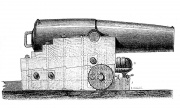
In 1823, the first guns to fire explosive shells with the flat trajectory of cannons were invented by the French General Henri-Joseph Paixhans. The guns were adopted by various navies from the 1840s, thereby triggering the demise of wooden ships, and the iron-hull revolution in shipbuilding. Cast-iron spherical common shell (so named because they were used against "common" targets) were in use up to 1871. Towards the end of this period they were fitted with a wooden disc called a sabot, attached by a copper rivet, intended to keep the fuze centered when loading. The sabot was also supposed to reduce the rebounding tendency of the shell as it traveled along the bore on discharge. Mortar shells were not fitted with sabots.
Cast iron was used for projectiles until the end of the 19th century, when steel came into use, first for projectiles intended for piercing armor, and later for use in high-velocity guns where the shock of discharge was too severe for cast iron.
During the First World War, shrapnel from explosive shells inflicted terrible casualties on infantry, accounting for nearly 70% of all war casualties and leading to the adoption of steel helmets on both sides. Shells filled with poison gas were used from 1917 onwards. Frequent problems with shells led to many military disasters when shells failed to explode, most notably during the 1916 Battle of the Somme.
Sizes
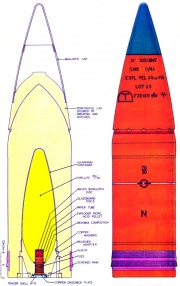
The calibre of a shell is its diameter. Depending on the historical period and national preferences, this may be specified in millimetres, centimetres, or inches. The length of gun barrels for large cartridges and shells (naval) is frequently quoted in terms of calibre. Some guns, mainly British, were specified by the weight of their shells (see below).
Due to manufacturing difficulties the smallest shells commonly used are around 20 mm calibre, used in aircraft cannon and on armoured vehicles. Smaller shells are only rarely used as they are difficult to manufacture and can only have a small explosive charge. The largest shells ever fired were those from the German super-railway guns, Gustav and Dora, which were 800 mm (31.5") in calibre. Very large shells have been replaced by rockets, guided missiles, and bombs, and today the largest shells in use are 203 mm (8 inches). Guns of that size are uncommon; 155 mm (6.1 inches) is the largest calibre in common use.
Gun calibres have standardized around a few common sizes, especially in the larger range, mainly due to the uniformity required for efficient military logistics. Shells of 105, 120, and 155 mm diameter are common for NATO forces' artillery and tank guns. Artillery shells of 122, 130 and 152 mm, and tank gun ammunition of 100, 115, or 125 mm calibre remain in use in Eastern Europe and China. Most common calibres have been in use for many years, since it is logistically complex to change the calibre of all guns and ammunition stores.
The weight of shells increases by and large with calibre. A typical 150 mm (5.9") shell weighs about 50 kg, a common 203 mm (8") shell about 100 kg, a concrete demolition 203 mm (8") shell 146 kg, a 280 mm (11") battleship shell about 300 kg, and a 460 mm (18") battleship shell over 1500 kg. The Schwerer Gustav supergun fired 4.8 and 7.1 tonne shells.
Old-style British classification by weight
British guns and ammunition were often described in pounds, e.g., as "two-pounder" shortened to "2-pdr". Usually this refers to the actual weight of a high explosive (HE) shell, but, confusingly, this was not always the case. Some were named after the weights of obsolete shell types of the same calibre, or even obsolete shell types that were considered to have been functionally equivalent. Also, shells fired from the same gun, but of different weight, took their name from the gun. Thus, conversion from "pounds" to an actual barrel diameter requires consulting a historical reference. This usage continued into the 1950s.
Types
There are many different types of shells. The principal ones include:
High-explosive (HE)
The most common shell type is high explosive, commonly referred to simply as HE. They have a strong steel case, a bursting charge, and a fuze. The fuse detonates the bursting charge which shatters the case and scatters hot, sharp case pieces (fragments, splinters) at high velocity. Most of the damage to soft targets such as unprotected personnel is caused by the blast rather than by fragments and splinters. The term "shrapnel" is sometimes incorrectly used to describe the shell splinters, but shrapnel shells functioned very differently and are long obsolete. Depending on the type of fuze used the HE shell can be set to burst on the ground (percussion), in the air above the ground (time or proximity), or after penetrating a short distance into the ground (percussion with delay, either to transmit more ground shock to covered positions, or to reduce the spread of fragments).
Early explosives used before and during World War I in HE shells were Lyddite (picric acid), PETN, TNT. Amatol was developed during WWI and was still in wide use in World War II, then RDX from 1945. Modern high explosives used include "Composition B" (cyclotol).
Mine shell
The mine shell is a particular form of HE shell developed for use in small caliber weapons such as 20 mm to 30 mm cannon. Small HE shells of conventional design can contain only a limited amount of explosive. By using a thin-walled steel casing of high tensile strength, a larger explosive charge can be used. Most commonly the explosive charge also was a more expensive but higher-detonation-energy type. The mine shell concept was invented by the Germans in the Second World War primarily for use in aircraft guns intended to be fired at opposing aircraft. Mine shells produced relatively little damage due to fragments, but a much more powerful blast. The aluminum structures and skins of Second World War aircraft were readily damaged by this greater level of blast.
Armour-piercing (AP)
- Main article: Armor-piercing shot and shell
The earliest naval and anti-tank shells had to withstand the extreme shock of punching through armour plate. Shells designed for this purpose sometimes had a greatly strengthened case with a small bursting charge, and sometimes were solid metal, i.e. shot. In either case, they almost always had a specially hardened and shaped nose to facilitate penetration. A further refinement of such designs improved penetration by adding a softer metal cap to the penetrating nose giving APC (Armour piercing - capped). The softer cap dampens the initial shock that would otherwise shatter the round. The best profile for the cap is not the most aerodynamic; this can be remedied by adding a further hollow cap of suitable shape: APCBC (APC + Ballistic Cap). AP shells with a bursting charge were sometimes distinguished by appending the suffix "HE". At the beginning of the Second World War, solid shot AP projectiles were common. As the war progressed, ordnance design evolved so that APHE became the more common design approach for anti-tank shells of 75 mm caliber and larger, and more common in naval shell design as well. In modern ordnance, most full caliber AP shells are APHE designs.
Armour-piercing, discarding-sabot (APDS)
- Main article: Armour-piercing discarding sabot
APDS was developed by engineers working for the French Edgar Brandt company, and was fielded in two calibers (75 mm/57 mm for the Mle1897/33 75 mm anti-tank cannon, 37 mm/25 mm for several 37 mm gun types) just before the French-German armistice of 1940. The Edgar Brandt engineers, having been evacuated to the United Kingdom, joined ongoing APDS development efforts there, culminating in significant improvements to the concept and its realization. British APDS ordnance for their QF 6 pdr and 17 pdr anti-tank guns was fielded in March 1944.
The armor-piercing concept calls for more penetration capability than the target's armour thickness. Generally, the penetration capability of an armor piercing round is proportional to the projectile's kinetic energy. Thus an efficient means of achieving increased penetrating power is increased velocity for the projectile. However, projectile impact against armour at higher velocity causes greater levels of shock. Materials have characteristic maximum levels of shock capacity, beyond which they may shatter on impact. At relatively high impact velocities, steel is no longer an adequate material for armor piercing rounds due to shatter. Tungsten and tungsten alloys are suitable for use in even higher velocity armour piercing rounds due to their very high shock tolerance and shatter resistance. However, tungsten is very dense, and tungsten rounds of full-caliber design are too massive to be accelerated to an efficient velocity for maximized kinetic energy. This is overcome by using a reduced-diameter tungsten shot, surrounded by a lightweight outer carrier, the sabot (a French word for a wooden shoe). This combination allows the firing of a smaller diameter (thus lower mass/aerodynamic resistance/penetration resistance) projectile with a larger area of expanding-propellant "push", thus a greater propelling force/acceleration/resulting kinetic energy.
Once outside the barrel, the sabot is stripped off by a combination of centripetal force and aerodynamic force, giving the shot low drag in flight. For a given caliber the use of APDS ammunition can effectively double the anti-tank performance of a gun.
Armour-piercing, fin-stabilized, discarding-sabot (APFSDS)
- Main article: Kinetic energy penetrator
An Armour-Piercing, Fin-Stabilised, Discarding Sabot (APFSDS) projectile uses the sabot principle with fin (drag) stabilisation. A long, thin sub-projectile has increased sectional density and thus penetration potential. However, once a projectile has a length-to-diameter ratio greater than 10 (less for higher density projectiles), spin stabilisation becomes ineffective. Instead, drag stabilisation is used, by means of fins attached to the base of the sub-projectile, making it look like a large metal arrow.
Large calibre APFSDS projectiles are usually fired from smooth-bore (unrifled) barrels, though they can be and often are fired from rifled guns. This is especially true when fired from small to medium calibre weapon systems. APFSDS projectiles are usually made from high-density metal alloys such as tungsten heavy alloys (WHA) or depleted uranium (DU); maraging steel was used for some early Soviet projectiles. DU alloys have better penetration than others as they are denser and self-sharpening, but they present radiological and toxic hazards that remain on the battlefield. The less toxic WHAs are preferred in most countries except the USA, UK, and Russia.
Armour-piercing, composite rigid (APCR)
Armour-Piercing, Composite Rigid is a British term, the US term for the design is High Velocity Armour Piercing (HVAP) and German, Hartkernmunition. The APCR projectile is a core of a high-density hard material such as tungsten carbide surrounded by a full-bore shell of a lighter material (e.g. an aluminium alloy). Most APCR projectiles are shaped like the standard APCBC shot (although some of the German Pzgr. 40 and some Soviet designs resemble a stubby arrow), but the projectile is lighter: up to half the weight of a standard AP shot of the same calibre. The lighter weight allows a higher velocity. The kinetic energy of the shot is concentrated in the core and hence on a smaller impact area, improving the penetration of the target armour. To prevent shattering on impact, a shock-buffering cap is placed between the core and the outer ballistic shell as with APC rounds. However, because the shot is lighter but still the same overall size it has poorer ballistic qualities, and loses velocity and accuracy at longer ranges. The APCR was superseded by the APDS which dispensed with the outer light alloy shell once the shot had left the barrel. The Germans used an APCR round, the Panzergranate 40 (Pzgr.40) "arrowhead" shot, for their 5 cm Pak 38 antitank guns in 1942, and it was also developed for their 75 and 88 mm antitank and tank guns, and for anti-tank guns mounted in German aircraft. Shortages of the key component, tungsten, led to the Germans dropping the use of APCR during late World War II because it was more efficiently used in industrial applications such as machine tools.
Armour-piercing, composite non-rigid (APCNR)
Armour-Piercing, Composite Non-Rigid (APCNR), the British term, is based on the same projectile design as the APCR - a high density core within a shell of soft iron or other alloy, but it is fired by a gun with a tapered barrel, either a taper in a fixed barrel (Gerlich design in German use; original development efforts in the late 1930s in Germany, Denmark and France) or a final added section as in the British "squeeze -bore" (Littlejohn adaptor). The projectile is initially full-bore, but the outer shell deforms as it passes through the taper. Flanges or studs are swaged down in the tapered section, so that as it leaves the muzzle the projectile has a smaller overall cross-section. This gives it better flight characteristics with a higher sectional density and the projectile retains velocity better at longer ranges than an undeformed shell of the same weight. As with the APCR the kinetic energy of the round is concentrated at the core on impact. The initial velocity of the round is greatly increased by the decrease of barrel cross-sectional area toward the muzzle, resulting in a commensurate increase in velocity of the expanding propellant gases. The Germans deployed their Schwere Panzerbüchse 41, their initial tapered barrel design, as a light anti-tank weapon early in the Second World War, but although HE projectiles were designed and put into service, the limiting of the shell diameter to the muzzle bore reduced their mass to only 85 grams and hence reduced their effectiveness. The British used the Littlejohn squeeze-bore adaptor which could be attached or removed as necessary, to extended the usefulness of their QF 2 pdr gun in armoured cars and light tanks which could not take a larger gun. Although a full range of shells and shot could be used, changing the adaptor in the heat of battle was highly impractical. The APCNR was superseded by the APDS design which was compatible with non-tapered barrels.
High-explosive, anti-tank (HEAT)
- Main article: High explosive anti-tank
HEAT shells are a type of shaped charge used to defeat armoured vehicles. They are extremely efficient at defeating plain steel armour but less so against later composite and reactive armour. The effectiveness of the shell is independent of its velocity, and hence the range: it is as effective at 1000 metres as at 100 metres. A HEAT charge is most effective when detonated at a certain, optimal, distance in front of the target and HEAT shells are usually distinguished by a long, thin nose probe sticking out in front of the rest of the shell and detonating it at the correct distance, e.g., PIAT bomb. HEAT shells are less effective if spun (i.e., fired from a rifled gun).
Discarding-sabot shell (DSS)
In principle the same as the APDS shot but applied to High Explosive Shells. It is a means to deliver a shell to a greater range. The design of the sub-projectile carried inside the sabot can be optimised for aerodynamic properties and the sabot can be built for best performance within the barrel of the gun. The principle was developed by a Frenchman, Edgar Brandt, in the 1930s. With the occupation of France, the Germans took the idea for application to anti-aircraft guns—a DSS projectile could be fired at a higher muzzle velocity and reach the target altitude quicker, simplifying aiming and allowing the target aircraft less time to change course.
High-explosive, squash-head (HESH) or high-explosive plastic (HEP)
- Main article: High explosive squash head
HESH is another anti-tank shell based on the use of explosive. Developed by the British inventor Sir Charles Dennistoun Burney in World War II for use against fortifications. A thin-walled shell case contains a large charge of a plastic explosive. On impact the explosive flattens, without detonating, against the face of the armour, and is then detonated by the fuze. Energy is transferred through the armour plate: when the compressive shock reflects off the air/metal interface on the inner face of the armour, it is transformed into a tension wave which spalls a "scab" of metal off into the tank damaging the equipment and crew without actually penetrating the armour.
HESH is completely defeated by spaced armour, so long as the plates are individually able to withstand the explosion. It is still considered useful as not all vehicles are equipped with spaced armour, and it is also the most effective munition for demolishing brick and concrete. HESH shells, unlike HEAT shells, can be fired from rifled guns.
Proof shot
- Main article: Proof Shot
A proof shot is not used in combat but to confirm that a new gun barrel can withstand operational stresses. The proof shot is heavier than a normal shot or shell, and an oversize propelling charge is used, subjecting the barrel to greater than normal stress. The proof shot is inert (no explosive or functioning filling) and is often a solid unit, although water, sand or iron powder filled versions may be used for testing the gun mounting. Although the proof shot resembles a functioning shell (of whatever sort) so that it behaves as a real shell in the barrel, it is not aerodynamic as its job is over once it has left the muzzle of the gun. Consequently it travels a much shorter distance, and if stopped by an earth bank or similar the impact is less.
The gun, operated remotely for safety in case it fails, fires the proof shot, and is then inspected for damage. If the barrel passes the examination "proof marks" are added to the barrel. The gun can be expected to handle normal ammunition, which subjects it to less stress than the proof shot, without being damaged.
Shrapnel shells
- Main article: Shrapnel
Shrapnel shells were an early (1784) anti-personnel munition which delivered large numbers of bullets at ranges far greater than rifles or machine guns could attain - up to 6,500 yards by 1914. A typical shrapnel shell as used in World War I was streamlined, 75 mm (3 inch) in diameter and contained approximately 300 lead-antimony balls (bullets), each approximately 1/2 inch in diameter. Shrapnel used the principle that the bullets encountered much less air resistance if they travelled most of their journey packed together in a single streamlined shell than they would if they travelled individually, and could hence attain a far greater range.
The gunner set the shell's fuze so that it was timed to burst as it was angling down towards the ground just before it reached its target (ideally about 150 yards before, and 60-100 feet above the ground[3]). The fuze then ignited a small "bursting charge" in the base of the shell which fired the balls forward out of the front of the shell case, adding approximately 200 - 250 ft/second to the existing velocity of 1200 - 750 ft/second. The shell case dropped to the ground and the bullets continued in an expanding cone shape before striking the ground over an area approximately 250 yards x 30 yards in the case of the US 3 inch shell.[4] The effect was of a large shotgun blast just in front of and above the target, and was deadly against troops in the open. A trained gun team could fire 20 such shells per minute, with a total of 6,000 balls, which compared very favourably with rifles and machine-guns.
However, shrapnel's relatively flat trajectory (it depended mainly on the shell's velocity for its lethality, and was only lethal in a forward direction) meant that it could not strike trained troops who avoided open spaces and instead used dead ground (dips), shelters, trenches, buildings, trees for cover. It was of no use in destroying buildings or shelters. Hence it was replaced during World War I by the high-explosive shell which exploded its fragments in all directions and could be fired by high-angle weapons such as howitzers, hence far more difficult to avoid.
Cluster shells
Like cluster bombs, an artillery shell may be used to scatter smaller submunitions, including anti-personnel grenades, anti-tank top-attack munitions, and landmines. These are generally far more lethal against both armor and infantry than simple high-explosive shells, since the multiple munitions create a larger kill zone and increase the chance of achieving the direct hit necessary to kill armor. Most modern armies make significant use of cluster munitions in their artillery batteries.
Artillery-scattered mines allow for the quick deployment of minefields into the path of the enemy without placing engineering units at risk, but artillery delivery may lead to an irregular and unpredictable minefield with more unexploded ordnance than if mines were individually placed. Signatories of the Ottawa Treaty have renounced the use of artillery-scattered mines.
Chemical
Chemical shells contain just a small explosive charge to burst the shell, and a larger quantity of a chemical agent such as a poison gas. Signatories of the Chemical Weapons Convention have renounced such shells.
Non-lethal shells
Not all shells are designed to kill or destroy. The following types are designed to achieve particular non-lethal effects. They are not completely harmless: smoke and illumination shells can accidentally start fires, and impact by the discarded carrier of all three types can wound or kill personnel, or cause minor damage to property.
Smoke
The smoke shell is designed to create a smokescreen. The main types are bursting (usually filled with white phosphorus, WP) and base ejection (a shell which scatters smoke grenades).
Illumination
An illumination shell has a fuze which ejects the "candle" (a pyrotechnic flare emitting white, coloured, or infrared light) at a calculated altitude, where it slowly drifts down beneath a heat resistant parachute, illuminating the area below. These are also known as starshell or star shell.
Carrier
The carrier shell is simply a hollow carrier equipped with a fuze which ejects the contents at a calculated time. They are often filled with propaganda leaflets (see external links), but can be filled with anything that meets the weight restrictions and is able to withstand the shock of firing. Famously, on Christmas Day 1899 during the siege of Ladysmith, the Boers fired into Ladysmith a carrier shell without fuze, which contained a Christmas pudding, two Union Flags and the message "compliments of the season". The shell is still kept in the museum at Ladysmith.
Fireworks
Aerial firework bursts are created by shells. In the United States, consumer firework shells may not exceed 1.75 inches in diameter.
Unexploded shells
- Main article: Unexploded ordnance
The fuze of a shell has to keep the shell safe from accidental functioning during storage, due to (possibly) rough handling, fire, etc, it also has to survive the violent launch through the barrel, then reliably function at the correct time. To do this it has a number of arming mechanisms, which are successively enabled under the influence of the firing sequence.
Sometimes, one or more of these arming mechanisms fails, and if the fuze is installed on an HE shell, it fails to detonate on impact. More worrying and potentially far more hazardous are fully armed shells on which the fuze fails to initiate the HE filling. This may be due to shallow, low velocity or soft impact conditions. Whatever the reason for failure, such a shell is called a blind or unexploded ordnance (UXO). The older term, "dud", is discouraged because it implies that the shell cannot detonate. Blind shells often litter old battlefields and depending on the impact velocity may be buried some distance into the earth, all remain potentially hazardous. For example, antitank ammunition with a piezoelectric fuze can be detonated by relatively light impact to the piezoelectric element, and others, depending on the type of fuze used can be detonated by even a small movement. The battlefields of the First World War still claim casualties today from leftover munitions. Thankfully modern electrical and mechanical fuzes are highly reliable, if they do not arm correctly they keep the initiation train out of line, or if electrical in nature, discharge any stored electrical energy.
Range enhancing technologies
Shells may be modified into RAP and Base bleed rounds to increase range.
See also
Notes
- ↑ 1.0 1.1 Needham, Joseph. (1986). Science and Civilization in China: Volume 5, Chemistry and Chemical Technology, Part 7, Military Technology; the Gunpowder Epic. Taipei: Caves Books Ltd. Page 24–25, 264.
- ↑ Cowley, Robert (1996). The Reader's Companion to Military History. Boston: Houghton–Mifflin Company. Page 49.
- ↑ I.V. Hogg & L.F. Thurston, "British Artillery Weapons & Ammunition". London: Ian Allan, 1972. Page 215.
- ↑ Douglas T Hamilton, "Shrapnel Shell Manufacture. A Comprehensive Treatise.". New York: Industrial Press, 1915, Page 13
References
- Douglas T Hamilton, "High-explosive shell manufacture; a comprehensive treatise". New York: Industrial Press, 1916
- Douglas T Hamilton, "Shrapnel Shell Manufacture. A Comprehensive Treatise". New York: Industrial Press, 1915
External links
- World War II propaganda leaflets: A website about airdropped, shelled or rocket fired propaganda leaflets. Example artillery shells for spreading propaganda.
- Artillery Tactics and Combat during the Napoleonic Wars
- [1]: 5 inch 54 caliber naval gun (5/54) shell.
